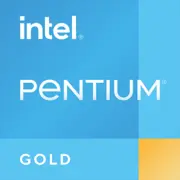Intel Pentium Gold G6605

Intel Pentium Gold G6605: Budget-Prozessor für grundlegende Aufgaben im Jahr 2025
Analyse von Möglichkeiten, Kompatibilität und Nutzungsszenarien
1. Hauptmerkmale: Architektur und Leistung
Der Prozessor Intel Pentium Gold G6605, der 2020 auf den Markt kam, bleibt aufgrund seines ausgeglichenen Verhältnisses eine aktuelle Budgetlösung.
Architektur und Fertigungsprozess
- Codename: Comet Lake (10. Generation Intel).
- Fertigungsprozess: 14 nm – veraltete Technologie, aber bietet Stabilität.
- Kerne und Threads: 2 Kerne, 4 Threads (Hyper-Threading).
- Cache: 4 MB L3.
- Integrierte Grafik: Intel UHD Graphics 630 (für grundlegende Aufgaben und leichte Spiele).
Leistung
- Geekbench 6: 935 (Single-Core), 1985 (Multi-Core).
- TDP: 58 W – geringer Stromverbrauch.
Wichtige Merkmale
- Unterstützung von Hyper-Threading zur Verbesserung der Multitasking-Fähigkeiten.
- Integrierte Grafik, die keine separate Grafikkarte benötigt.
- Kompatibilität mit DDR4 und PCIe 3.0.
2. Kompatible Motherboards: Sockel und Chipsätze
Sockel: LGA 1200.
Chipsätze:
- H410/B460/H470: optimale Wahl für Budget-Bauten (Preis: 70–100 USD).
- Z490: überflüssig (unterstützt Übertaktung, aber G6605 ist blockiert).
Auswahlkriterien
- Stellen Sie sicher, dass das Mainboard die Prozessoren der 10. Generation unterstützt (häufig ist ein BIOS-Update für neue Chargen erforderlich).
- Beispiele für Modelle aus dem Jahr 2025: ASRock B460M-HDV, Gigabyte H410M-H.
3. Unterstützter Speicher: DDR4 und dessen Konfigurationen
- Typ: Nur DDR4 (kein Unterstützung für DDR5).
- Frequenz: Bis zu 2666 MHz (Einschränkung durch die Chipsätze H410/B460).
- Empfehlungen:
- 8 GB für Büroarbeiten.
- 16 GB für leichtes Videomontieren oder Multitasking.
- Kosten: 8 GB DDR4-2666 – ab 30 USD, 16 GB – ab 55 USD (neue Module, 2025).
4. Netzteile: Leistungsberechnung
- Basisberechnung: 58 W (TDP des Prozessors) + 50–100 W (andere Komponenten).
- Szenarien:
- Ohne Grafikkarte: 300 W (zum Beispiel be quiet! Pure Power 11 300W, 45 USD).
- Mit dedizierter GPU (z.B. GTX 1650): 450–500 W (EVGA 500 BR, 55 USD).
- Tipp: Wählen Sie Netzteile mit 80+ Bronze-Zertifizierung für mehr Effizienz.
5. Vor- und Nachteile des Prozessors
Vorteile:
- Günstiger Preis (70–80 USD im Jahr 2025).
- Energieeffizienz.
- Integrierte Grafik für grundlegende Aufgaben.
Nachteile:
- Nur 2 Kerne – schwache Multithreading-Leistung.
- Veralteter 14-nm-Fertigungsprozess.
- Kein Support für PCIe 4.0 und DDR5.
6. Nutzungsszenarien
- Büro und Studium: Arbeiten mit Dokumenten, Browser, Zoom.
- Multimedia: Streaming von Videos (YouTube, Netflix), Musik.
- Leichte Spiele: CS:GO (720p, 40–50 FPS), League of Legends (niedrige Einstellungen).
- Nicht geeignet für: Videobearbeitung, 3D-Rendering, moderne AAA-Spiele.
Praktisches Beispiel: Aufbau für die Eltern – schneller Start von Anwendungen, Filme anschauen, ohne Überzahlungen.
7. Vergleich mit Wettbewerbern
- AMD Athlon 3000G (2 Kerne/4 Threads, Vega 3):
- Günstiger (60 USD), aber schwächer in Single-Core-Anwendungen (Geekbench 6: ~800/1750).
- Intel Core i3-10100 (4 Kerne/8 Threads):
- Preis 100–120 USD, Multithreading-Leistung um 40% höher.
- Fazit: Pentium Gold G6605 ist die goldene Mitte zwischen Athlon und i3.
8. Praktische Tipps zum Aufbau
- Motherboard: ASRock B460M-HDV + Pentium Gold G6605.
- Speicher: 8–16 GB DDR4-2666 (Crucial, Kingston).
- Speicherlaufwerk: SSD 256 GB (WD Green, 35 USD).
- Gehäuse: MicroATX mit Belüftung (Deepcool MATREXX 30, 40 USD).
- Kühlung: Achtung – der Standardkühler ist ausreichend.
Wichtig: Überprüfen Sie die BIOS-Kompatibilität vor dem Kauf des Mainboards!
9. Endgültige Schlussfolgerung: Für wen ist der Pentium Gold G6605 geeignet?
Dieser Prozessor ist die ideale Wahl für:
- Budget-PCs: Büro, Studium, Home Theater (HTPC).
- Nutzer, die keine hohe Leistung benötigen: Rentner, Kinder.
- Übergangslösungen: Aufbau „für jetzt“ mit der Möglichkeit zur Aufrüstung.
Warum im Jahr 2025? Trotz seines Alters bleibt G6605 eine günstige Option für grundlegende Aufgaben aufgrund des niedrigen Preises und der Energieeffizienz. Für Gaming oder intensive Arbeiten sollten jedoch modernere CPUs in Betracht gezogen werden.
Zusammenfassung: Der Pentium Gold G6605 ist ein bescheidener, aber zuverlässiger "Arbeits"-Prozessor. Er wird nicht durch Leistung überraschen, bewältigt jedoch alltägliche Aufgaben ohne unnötige Kosten.
Basic
CPU-Spezifikationen
Speicherspezifikationen
GPU-Spezifikationen
Verschiedenes
Benchmarks
Im Vergleich zu anderen CPUs
In sozialen Medien teilen
Oder verlinken Sie uns
<a href="https://cputronic.com/de/cpu/intel-pentium-gold-g6605" target="_blank">Intel Pentium Gold G6605</a>